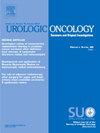学术和社区医疗网络之间 PI-RADS 评分的读数间可靠性和诊断准确性:差距有多大?
IF 2.3
3区 医学
Q3 ONCOLOGY
Urologic Oncology-seminars and Original Investigations
Pub Date : 2024-10-22
DOI:10.1016/j.urolonc.2024.10.002
引用次数: 0
摘要
重要性:前列腺成像报告和数据系统(PI-RADS)评分指南的制定是为了解决前列腺癌(PCa)多参数磁共振成像(mpMRI)结果的解释和报告中存在的巨大差异,随后的更新旨在进一步提高阅片人员之间的可靠性。尽管如此,PI-RADS评分在实际环境中的变异性可能会对前列腺mpMRI的广泛标准化构成持续挑战,并限制其整体临床效益:为了评估 PCa mpMRI 解释和报告的变异性,我们评估了社区医疗机构和三级学术护理中心在 PI-RADS 评分方面的差异:我们确定了 2016 年 1 月至 2022 年 7 月期间由本机构放射科医师重新解读的 262 项来自非学术机构的 mpMRI 研究。我们确定了其中 193 名患者的磁共振成像融合活检结果,共计 302 个病灶。除了靶向核芯病理分析中是否存在有临床意义的 PCa(csPCa)外,还记录了社区和学术判读员的 PI-RADS 评分:主要结果是通过类内相关性(ICC)和卡帕统计量得出的译员间可靠性。我们还通过接收器操作者特征(ROC)分析评估了PI-RADS评分对两个队列检测csPCa的诊断准确性,并使用配对样本曲线下面积差分析比较了这些结果:每个病灶的 PI-RADS 评分的读者间一致性和可靠性普遍较差(绝对一致性 ICC = 0.393,95% CI:0.288-0.488;一致性 ICC = 0.407,95% CI:0.308-0.497;kappa = 0.336,95% CI:0.267-0.406)。PI-RADSv2.1发布后进行的研究得出的可靠性结果与总体分析结果相似。在由社区口译员评分为 PIRADS 3 的病变亚组中未观察到一致性。各组间的诊断准确性无明显统计学差异(ROC 曲线下面积 [AUC]:分别为 0.759 vs. 0.785;P = 0.337)。在两个队列中,PI-RADS 3 被确定为检测临床重大疾病的最佳临界值:我们的研究结果表明,mpMRI 在检测 csPCa 方面的诊断准确性在学术界和社区医疗机构之间没有显著差异。然而,在不同队列之间观察到的 mpMRI 可靠性明显较差,这表明在社区前列腺癌管理中存在引入实践差异的风险。差异(尤其是针对 PI-RADS 3 病变)可能会导致活检建议不一致,从而导致漏诊 csPCa 或不必要的活检。本文章由计算机程序翻译,如有差异,请以英文原文为准。
Inter-reader reliability and diagnostic accuracy of PI-RADS scoring between academic and community care networks: How wide is the gap?
Importance
The Prostate Imaging Reporting & Data System (PI-RADS) scoring guidelines were developed to address the substantial variation in interpretation and reporting of prostate cancer (PCa) multiparametric MRI (mpMRI) results, and subsequent updates have sought to further improve inter-reader reliability. Nonetheless, the variability of PI-RADS scoring in real-world settings may represent a continuing challenge to the widespread standardization of prostate mpMRI and limit its overall clinical benefit.
Objective
To assess variability in mpMRI interpretation and reporting of PCa, we evaluated the discrepancies in PI-RADS scoring between community practices and a tertiary academic care center.
Design, setting, and participants
We identified 262 mpMRI studies from nonacademic facilities, reinterpreted by radiologists at our institution between January 2016 and July 2022. Results of targeted MRI fusion biopsy were identified for 193 of these patients, totaling 302 lesions. PI-RADS scoring from both community and academic interpreters were recorded in addition to presence of clinically significant PCa (csPCa) on pathological analysis of targeted cores.
Main Outcome and measures
The primary outcome was inter-reader reliability via intraclass correlation (ICC) and the kappa statistic. We also assessed the diagnostic accuracy of PI-RADS scoring for detecting csPCa for both cohorts via receiver operator characteristics (ROC) analysis and compared these findings using paired-sample area difference under curve analysis.
Results
Inter-reader agreement and reliability of PI-RADS scoring per lesion was generally poor (absolute agreement ICC = 0.393, 95% CI: 0.288–0.488; consistency ICC = 0.407, 95% CI: 0.308–0.497; kappa = 0.336, 95% CI: 0.267–0.406). Reliability results from studies obtained after the publication of PI-RADSv2.1 were similar to those of the overall analysis. No agreement was observed in the subgroup of lesions scored as PIRADS 3 by community interpreters. No statistically significant difference in diagnostic accuracy was observed between cohorts (ROC area under curve [AUC]: 0.759 vs. 0.785, respectively; P = 0.337). PI-RADS 3 was determined to be the optimal cutoff for detecting clinically significant disease in both cohorts.
Conclusions and relevance
Our results suggest that mpMRI diagnostic accuracy for detecting csPCa is not significantly different between academic and community practices. However, significantly poor reliability of mpMRI was observed between cohorts, suggesting the risk of introducing practice variation for community prostate cancer management. Variability, particularly for PI-RADS 3 lesions, can lead to inconsistent biopsy recommendations, which may result in missed csPCa or unnecessary biopsies.
求助全文
通过发布文献求助,成功后即可免费获取论文全文。
去求助
来源期刊
CiteScore
4.80
自引率
3.70%
发文量
297
审稿时长
7.6 weeks
期刊介绍:
Urologic Oncology: Seminars and Original Investigations is the official journal of the Society of Urologic Oncology. The journal publishes practical, timely, and relevant clinical and basic science research articles which address any aspect of urologic oncology. Each issue comprises original research, news and topics, survey articles providing short commentaries on other important articles in the urologic oncology literature, and reviews including an in-depth Seminar examining a specific clinical dilemma. The journal periodically publishes supplement issues devoted to areas of current interest to the urologic oncology community. Articles published are of interest to researchers and the clinicians involved in the practice of urologic oncology including urologists, oncologists, and radiologists.

 求助内容:
求助内容: 应助结果提醒方式:
应助结果提醒方式:


